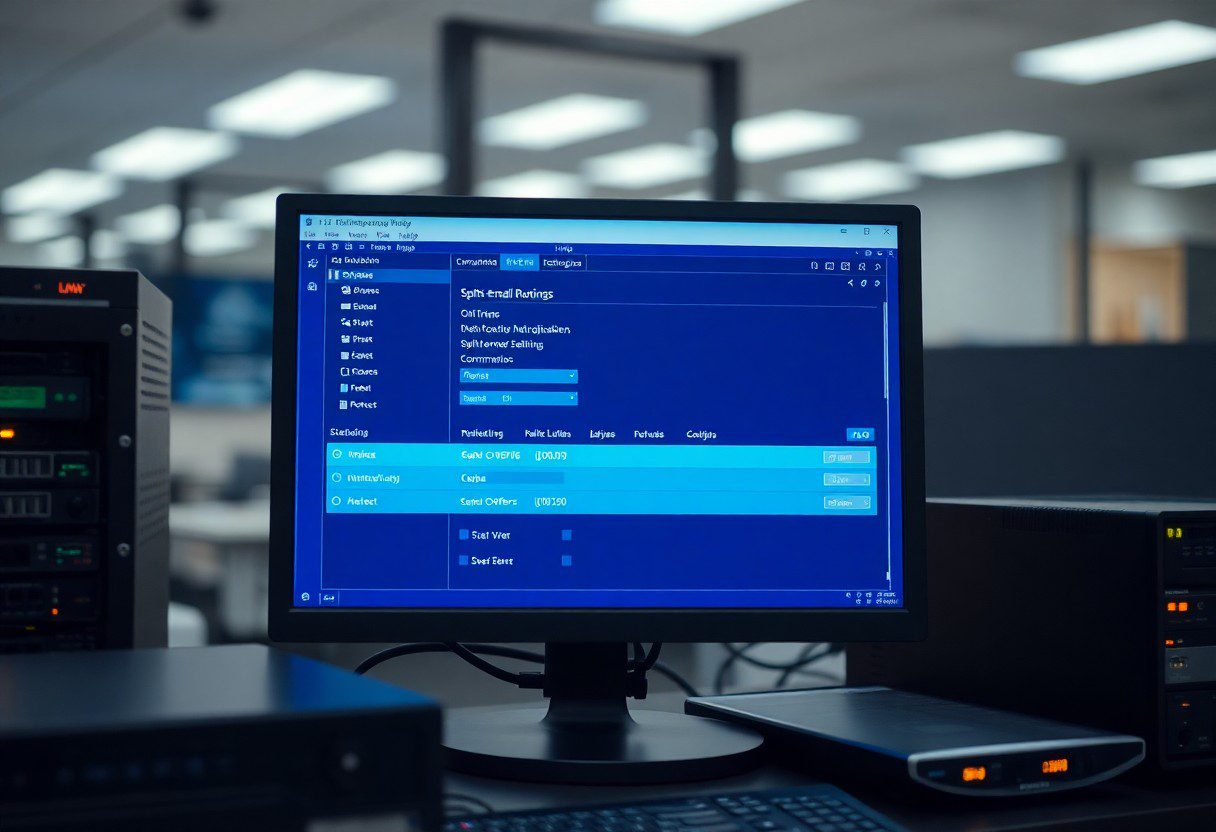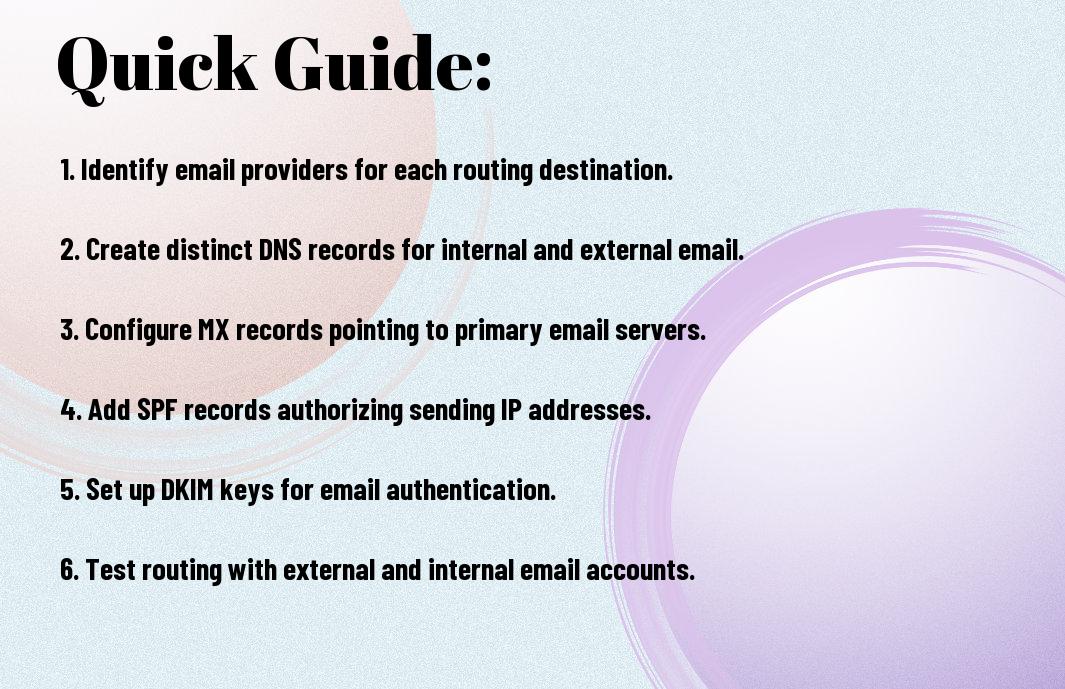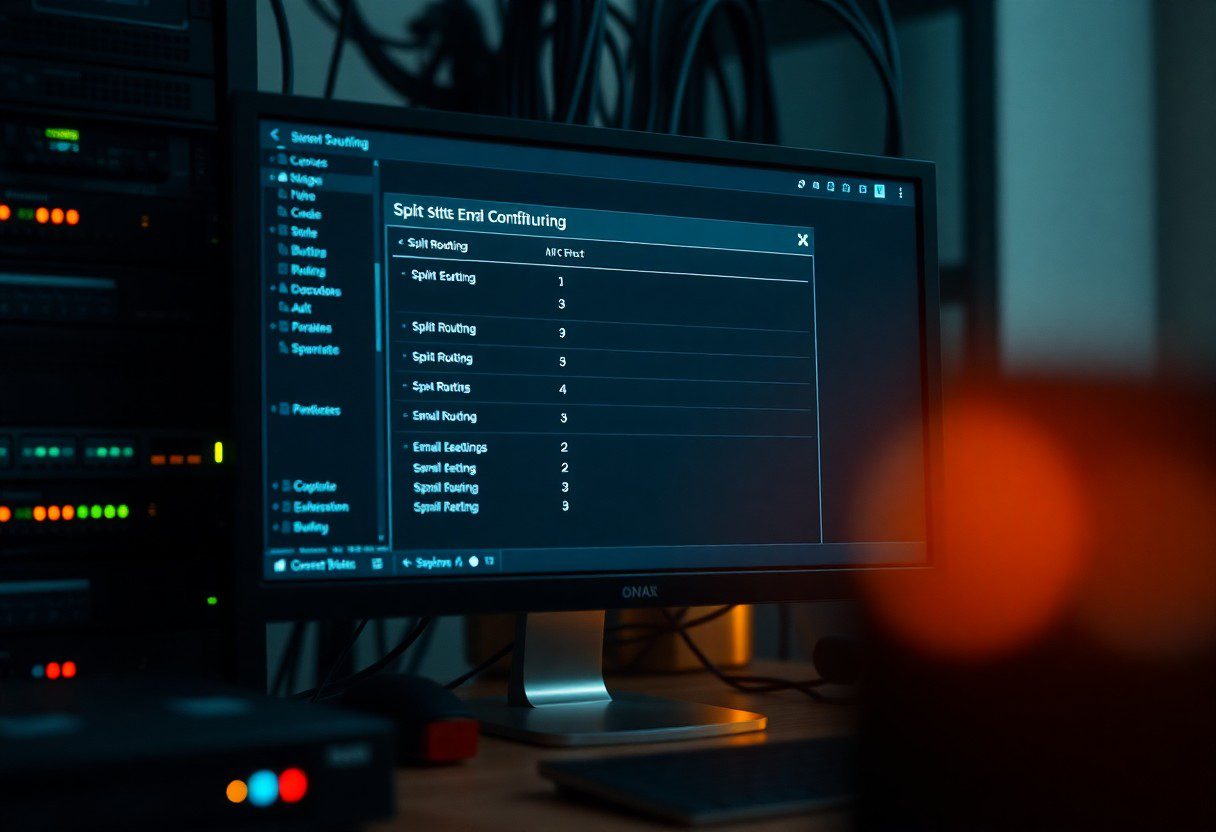Navigating the Landscape of Split Email Routing
Understanding the intricacies of split email routing enables you to efficiently manage how emails are directed within your organization. For instance, if your business operates in multiple geographic regions, split routing can enhance performance by directing local traffic to regional servers, thus reducing latency. For example, a company with teams in both Europe and North America might route emails through regional servers that improve speed and reliability. Additionally, incorporating different email platforms—like Gmail and Microsoft 365—can serve specialized purposes, harmonizing workflows while still addressing unique departmental needs effectively.
Key Takeaways:
- Split email routing involves directing emails to different servers based on specific criteria, improving management and delivery efficiency.
- Proper DNS configuration is vital to ensure that emails are routed correctly; this includes setting up MX records appropriately.
- Utilizing subdomains can simplify the management of different email routes, providing a clearer structure for handling emails.
- Monitoring tools can be beneficial for tracking performance and diagnosing issues in email delivery across different routes.
- Regularly reviewing and updating DNS settings helps maintain optimal email routing as organizational needs evolve.

The Role of DNS in Email Delivery
DNS is a fundamental component in the email delivery process, serving as the backbone that translates domain names into IP addresses. This translation ensures that emails are routed accurately to their respective destinations. Misconfigurations within the DNS system can lead to delivery failures, where emails may end up undelivered or misdirected. Understanding the mechanics behind DNS not only enhances email functionality but also increases overall reliability in communications.
Domain Name System Fundamentals
The Domain Name System (DNS) is importantly a directory of the internet, converting user-friendly domain names into machine-readable IP addresses. Each domain is associated with a series of DNS records that provide important information about the server configuration for hosting email, including MX (Mail Exchange) records, which specifically guide the path for email delivery.
How DNS Affects Email Routing
Your DNS settings play a significant role in how emails are routed. The presence and accuracy of MX records in your DNS configuration directly determine which mail servers will accept and deliver emails for your domain. If these records are not properly defined or if they point to incorrect servers, mail delivery can be severely disrupted.
For instance, when a sender writes an email to your address, their mail server queries the DNS for your domain’s MX records to find the correct server to send the email to. If your DNS records have multiple MX entries, each with a priority setting, this creates a hierarchy. Higher priority records are queried first, but if they fail, lower-priority records are used. Therefore, ensuring that these MX records are meticulously entered and tested can guarantee smooth and efficient email routing, minimizing potential disruptions in your communication flow.

Essential DNS Records for Split Email Management
Managing split email routing effectively requires a solid understanding of necessary DNS records. Each record type plays a specific role in ensuring smooth email delivery and security. By correctly configuring these records, you can improve deliverability and maintain the integrity of your email communications across multiple domains.
MX Records: The Heart of Email Delivery
MX records are the backbone of email delivery as they dictate which mail servers are responsible for receiving your domain’s emails. You can assign multiple MX records with different priorities to ensure redundancy; this means that if your primary email server goes down, incoming emails can still be directed to backup servers, providing a consistent email experience for your users.
SPF and DKIM: Securing Your Email Flow
SPF (Sender Policy Framework) and DKIM (DomainKeys Identified Mail) are necessary measures for authenticating your email, minimizing the chance of spoofing or phishing. By implementing these protocols, you create a stronger trust relationship with email providers, increasing the likelihood that your messages land in the inbox rather than the spam folder.
SPF allows you to designate which IP addresses are authorized to send emails on behalf of your domain. You create a text record that lists these IP addresses, which email servers reference when receiving messages. DKIM, on the other hand, involves applying a digital signature to your emails, enabling receiving servers to verify that the email hasn’t been altered in transit. Both measures work in tandem to enhance the credibility of your outgoing emails, ultimately improving overall deliverability rates.
TXT Records: Enhancing Deliverability
TXT records serve multiple purposes, often including additional verification measures such as SPF and DKIM. By utilizing TXT records, you can enhance the deliverability of your emails and share important information with email servers regarding their configuration and authentication methods.
In many cases, TXT records are also used for DMARC (Domain-based Message Authentication, Reporting & Conformance), which builds upon SPF and DKIM by providing instructions for handling unauthorized emails. A well-configured DMARC policy can significantly bolster your email security and give you insights into how your domain is being used across the internet. Using TXT records effectively can not only minimize spoofing risks but also maintain brand reputation and deliverability.
Practical Implementation Steps for Split Email Routing
Implementing split email routing involves multiple steps to ensure seamless communication between different mail servers. Begin by assessing your current email infrastructure, then proceed to configure your DNS settings, followed by rigorous testing and troubleshooting. Through careful planning and execution, you can successfully manage email traffic across various destinations while maintaining optimal performance and reliability.
Configuring Your DNS for Multiple Mail Servers
Your DNS configuration sets the backbone for effective split email routing. Start by creating MX records that designate different priorities for your mail servers. Assign lower preference values to primary servers while setting higher values for backup ones. Make sure to specify the correct IP addresses and server names in each record to ensure proper routing of incoming emails based on the defined hierarchy.
Testing Your Setup: Tools and Techniques
After configuring your DNS settings, validating your email routing setup is necessary. Utilize tools like MXToolbox for MX record lookups and email tracing. You can also send test emails to verify the correct server handles incoming messages, helping you identify any routing issues that may arise.
Focus on both DNS and server-side validation to comprehensively test your setup. Use command-line tools like ‘dig’ or ‘nslookup’ to ensure your DNS records propagate correctly across different regions. Simultaneously, monitor server logs to confirm that emails are being processed as expected. If delays or discrepancies occur, they can provide critical insights into the effectiveness of your split routing strategy.
Troubleshooting Common Issues
Even with meticulous setup, issues may emerge during email routing. Common problems include delayed email deliveries or misrouted messages. Start by reviewing your DNS settings for typos or incorrect server configurations, which often lead to such pitfalls. Utilize your email servers’ logs to diagnose root causes effectively.
Pay attention to TTL settings and how quickly changes propagate. Issues like DNS caching can affect immediate changes to MX records. Additionally, verify ports and firewall settings on your servers, as misconfigured firewalls can block incoming email traffic. By systematically addressing these areas, you can resolve common complications and ensure smooth email delivery.
Advanced Strategies for Optimizing Split Email Routing
To fine-tune split email routing, leveraging advanced strategies can significantly enhance delivery efficiency and reliability. Consider the following techniques:
- Implement load balancing to manage email traffic.
- Establish failover mechanisms for added redundancy.
- Analyze performance metrics to identify areas for improvement.
Email Optimization Techniques
| Load Balancing | Distributing incoming email traffic across multiple servers for improved performance. |
| Failover Mechanisms | Backup systems to seamlessly handle email delivery when primary systems fail. |
| Performance Metrics | Monitoring key performance indicators to fine-tune your email routing setup. |
Load Balancing Email Traffic
Distributing email traffic across several servers optimizes resource use and minimizes latency. By employing a load balancer, you ensure that no single server becomes overwhelmed, which helps maintain consistent email delivery times and enhances the overall user experience.
Implementing Failover Mechanisms
Failover mechanisms provide an crucial backup during server failures, guaranteeing that email routing remains uninterrupted. With automated systems in place, your emails continue to deliver smoothly even during unexpected server downtimes.
Implementing failover mechanisms may involve configuring secondary servers set to activate automatically if the primary server goes offline. Utilizing DNS records such as MX records with varying priorities can enable this functionality, allowing your emails to reroute to backup servers without the user noticing a delay. This proactive approach ensures uninterrupted communication and maintains the reputation of your email service.
Analyzing Performance Metrics
Regularly analyzing performance metrics is key to fine-tuning your email routing strategies. Metrics like delivery rates, response times, and bounce rates provide insights into the effectiveness of your current configuration.
Performance metrics can reveal potential bottlenecks in your email routing system. By tracking these data points, you can identify trends and adjust settings to enhance bin configurations. For example, if you notice increased bounce rates, it may prompt a review of your DNS configurations or server response times, allowing for timely improvements that bolster your email delivery success.

Best Practices for Maintaining DNS Health
Ensuring the health of your DNS configuration is vital for reliable email routing. Implementing best practices helps prevent downtime and enhances service integrity. Regular monitoring, periodic audits, and a well-documented infrastructure all contribute to maintaining an efficient and resilient system.
Regular Audits and Updates
Conducting regular audits of your DNS settings allows you to identify outdated records or misconfigurations that could disrupt email functionality. Scheduling these assessments at least twice a year ensures that your records align with organizational changes and keeps your email routing efficient.
Monitoring and Managing DNS TTL Settings
DNS Time-to-Live (TTL) settings dictate how long records are cached by resolvers. By monitoring these values, you can balance between minimizing lookup times and ensuring that changes propagate quickly, especially when altering DNS configurations or troubleshooting issues.
Adjusting TTL settings accordingly can significantly improve the responsiveness of your email routing. Shorter TTL values, for instance, allow for faster updates when changes are needed, but they may increase query loads on your DNS server. Conversely, longer TTLs reduce query frequency but can delay the effect of important changes, which is especially problematic during migration or when making critical adjustments. Finding the right balance based on your needs and traffic patterns is important for maintaining optimal performance.
Documenting Your DNS Configuration
Thorough documentation of your DNS settings enables quick reference and troubleshooting capabilities when issues arise. Maintaining an updated record of configurations, changes, and the rationale behind them helps streamline the management and enhances team collaboration.
Creating a comprehensive DNS documentation protocol includes outlining record types, TTL values, and the role of each in your email routing strategy. By annotating each record with corresponding changes made and the reasons behind those adjustments, you will establish a valuable knowledge base for future audits or team training. This not only expedites your response to issues but also assists in onboarding new team members, ensuring everyone is on the same page regarding the DNS setup and its importance to your email routing infrastructure.
Final Thoughts on Mastering DNS for Efficient Email Routing
Optimizing your DNS configuration for effective email routing can lead to significant improvements in deliverability and performance. By continuously monitoring your DNS records and making informed adjustments, you can reduce latency and bolster security against potential threats. Employing tools like DNS analytics can reveal insights to fine-tune your setup further, ensuring that your emails reach their intended destinations reliably. Additionally, learning from case studies where businesses saw marked increases in engagement through better DNS practices can serve as motivation to refine your own approach. Mastery of DNS not only enhances email flow but also strengthens your overall digital infrastructure.
FAQ
Q: What is split email routing and why would I use it?
A: Split email routing is a strategy that allows organizations to send different types of emails to different servers based on pre-defined rules. This can be beneficial for large enterprises that use multiple email services or those that wish to separate internal and external email flows. By implementing split email routing, businesses can optimize their email processing, enhance security, and ensure compliance with data management policies.
Q: How do I configure DNS settings for split email routing?
A: To configure DNS settings for split email routing, you typically need to create MX (Mail Exchange) records that direct incoming email to different servers based on criteria such as domain names. First, gather the necessary information about your email service providers and their respective server addresses. Then, log in to your DNS management console, add the relevant MX records, and adjust the priority settings to define which server handles email first. Lastly, allow DNS changes to propagate before testing the setup.
Q: What kind of challenges might I face when implementing split email routing?
A: When implementing split email routing, you may encounter several challenges including potential misconfiguration of DNS records, which can lead to email delivery failures. Additionally, there may be complexities around maintaining the necessary security protocols for different email servers. Finally, issues could arise in management and monitoring, as multiple services may require different settings and regular checks to ensure proper functioning.
Q: Can I use split email routing with various mail providers and services?
A: Yes, split email routing can be implemented with various mail providers and services, as long as they support MX records. However, it’s important to ensure compatibility between your selected email services and the routing rules you plan to set up. Review the documentation for each provider and ensure that their configurations will work harmoniously together to avoid delivery issues.
Q: How can I verify that my split email routing is configured correctly?
A: To verify your split email routing configuration, perform several tests. Start by sending test emails from different source addresses to various destination addresses. Monitor the delivery paths to confirm that emails are being routed to the appropriate servers based on your designated rules. Additionally, utilize tools such as DNS lookup services and email tracing to check that your MX records are correctly set up and resolving as expected. Observing the response times and success rates will also help identify any potential issues in the routing setup.

